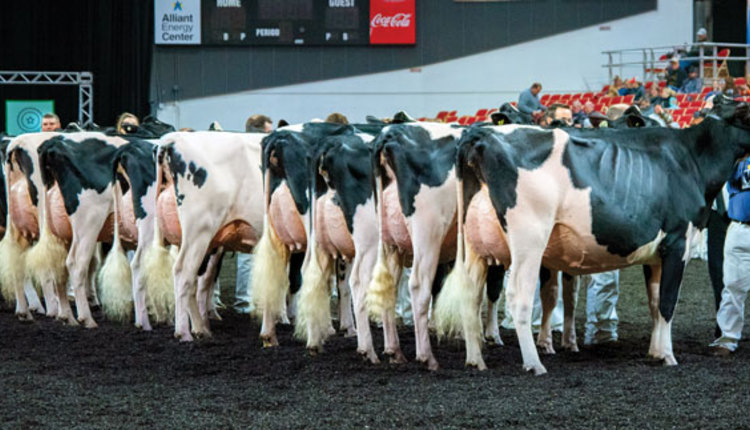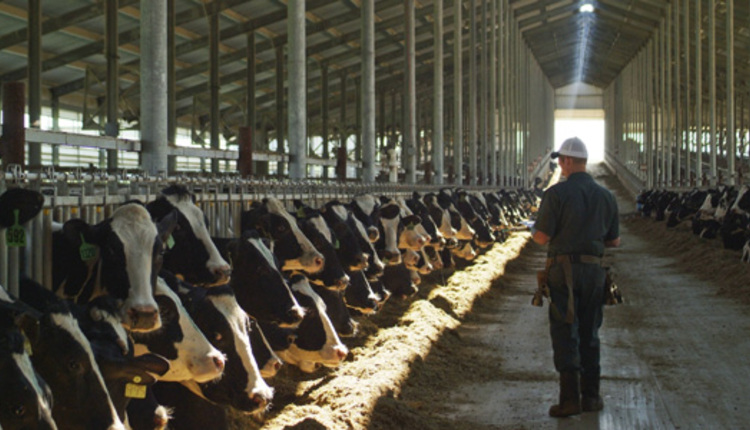School of Veterinary Medicine, University of Wisconsin
VETERINARY COLUMN LETTER:
I have a small herd with 70 cows and 50 to 70 head of young stock. The most calves I ever have on milk are 12.
Currently, I am raising them in hutches on a 60- by 60-foot gravel pad. In summer, I put a shade cloth up to help keep them cool. I have been thinking about doing something different . . . a little less labor intensive to be specific. The shade cloth is extremely challenging and becoming too much work to put up each spring.
I am thinking about putting up a small calf barn, but I am not sure where to look for the designs. I thought maybe you had seen a lot of different structures and could tell me what works best.
I have always heard that calf hutches are the best way to raise calves, but I've reached a point where I would like to change what I am doing. I would like to keep it small, simple, and accessible for a skid loader. I still would raise calves in separate pens, and I want to make sure the building would be as comfortable as possible throughout the year. I have some ideas of my own but thought I would see if I could get some input from someone who has seen different buildings.~MARYLAND
Calf hutches have many positive aspects, but they require excellent management for best calf health, and the seasonal challenges of extreme heat or cold often trigger the desire to look for other housing options. As you move forward with plans for a calf barn, think about keeping some hutches. Being able to completely empty, clean, disinfect, and rest your new calf barn once each year gives you a significant opportunity to improve calf health and performance by lowering the population of resident organisms in the building.
We don't know of a single-style calf barn that works for everyone, so we have chosen to answer your question by providing a list of our priorities for the calf barn. We'll keep in mind your goals of having a barn that is small and simple, has individual pens, is skid-loader accessible, and provides year-round comfort for calves and workers.
• With a maximum of 12 calves on milk at any one time, consider a one-row, naturally ventilated barn.
• It is very likely that a supplemental, positive-pressure ventilation system will be needed to bring outside air directly into individual calf pens to reduce exposure to aerosolized bacteria and viruses in the pen environment. You can find specific recommendations by clicking on "Recommendations for naturally ventilated calf barns" at this website: http://svmweb.vetmed.wisc.edu/dms/fapm/fapmtools/calves.htm.
• Have 10 percent more calf pens than the number of calves at maximum occupancy. In your case, you will need 13 or 14 individual calf pens.
• Individual pens should be 28 square feet, such as 4 by 7 feet, or larger.
• Put solid panels between calf pens that have extensions on the front of the pen to prevent calf-to- calf contact.
• Keep the front and back of individual pens as open as possible.
• For the floor surface, consider deep gravel or concrete. A gravel base of 10 to 15 inches with tile at the bottom allows fluids to drain quickly down and out of the barn. You can remove a thin layer of the pea gravel and replace it when the pens are cleaned after each use. One of the primary benefits of the gravel base is that a similar dry bed can be achieved with about half the quantity of straw compared to a concrete floor. We don't recommend sand as a base as opposed to gravel. Straw seems to get mixed with the sand, creating an unsatisfactory surface.
Concrete floors are necessary if you are considering in-floor heat. The concrete floor should slope away from the feeding area of the calf pen to a gutter behind the rear of the pen.
• For temperatures lower than 55°, make sure calves are bedded in straw that has enough depth and loft to completely cover the legs when the calf is lying down. You can consider other bedding types when barn temperature is within the thermoneutral zone (55 to 75°). In general, the finer the bedding, the more likely that the bedding retains manure and urine and, therefore, the faster bacteria counts build up in the bedding.
• Have alley widths that provide access to the skid loader in front (feeding access) and in back (waste removal) of the pens. Dump all refused feed (liquid and solid) and water into a container on the skid loader and remove them from the calf barn.
We hope that this list of priorities is helpful as you plan your new calf barn.
Click here to return to the Calf & Heifer E-Sources
090925_602
VETERINARY COLUMN LETTER:
I have a small herd with 70 cows and 50 to 70 head of young stock. The most calves I ever have on milk are 12.
Currently, I am raising them in hutches on a 60- by 60-foot gravel pad. In summer, I put a shade cloth up to help keep them cool. I have been thinking about doing something different . . . a little less labor intensive to be specific. The shade cloth is extremely challenging and becoming too much work to put up each spring.
I am thinking about putting up a small calf barn, but I am not sure where to look for the designs. I thought maybe you had seen a lot of different structures and could tell me what works best.
I have always heard that calf hutches are the best way to raise calves, but I've reached a point where I would like to change what I am doing. I would like to keep it small, simple, and accessible for a skid loader. I still would raise calves in separate pens, and I want to make sure the building would be as comfortable as possible throughout the year. I have some ideas of my own but thought I would see if I could get some input from someone who has seen different buildings.~MARYLAND
Calf hutches have many positive aspects, but they require excellent management for best calf health, and the seasonal challenges of extreme heat or cold often trigger the desire to look for other housing options. As you move forward with plans for a calf barn, think about keeping some hutches. Being able to completely empty, clean, disinfect, and rest your new calf barn once each year gives you a significant opportunity to improve calf health and performance by lowering the population of resident organisms in the building.
We don't know of a single-style calf barn that works for everyone, so we have chosen to answer your question by providing a list of our priorities for the calf barn. We'll keep in mind your goals of having a barn that is small and simple, has individual pens, is skid-loader accessible, and provides year-round comfort for calves and workers.
• With a maximum of 12 calves on milk at any one time, consider a one-row, naturally ventilated barn.
• It is very likely that a supplemental, positive-pressure ventilation system will be needed to bring outside air directly into individual calf pens to reduce exposure to aerosolized bacteria and viruses in the pen environment. You can find specific recommendations by clicking on "Recommendations for naturally ventilated calf barns" at this website: http://svmweb.vetmed.wisc.edu/dms/fapm/fapmtools/calves.htm.
• Have 10 percent more calf pens than the number of calves at maximum occupancy. In your case, you will need 13 or 14 individual calf pens.
• Individual pens should be 28 square feet, such as 4 by 7 feet, or larger.
• Put solid panels between calf pens that have extensions on the front of the pen to prevent calf-to- calf contact.
• Keep the front and back of individual pens as open as possible.
• For the floor surface, consider deep gravel or concrete. A gravel base of 10 to 15 inches with tile at the bottom allows fluids to drain quickly down and out of the barn. You can remove a thin layer of the pea gravel and replace it when the pens are cleaned after each use. One of the primary benefits of the gravel base is that a similar dry bed can be achieved with about half the quantity of straw compared to a concrete floor. We don't recommend sand as a base as opposed to gravel. Straw seems to get mixed with the sand, creating an unsatisfactory surface.
Concrete floors are necessary if you are considering in-floor heat. The concrete floor should slope away from the feeding area of the calf pen to a gutter behind the rear of the pen.
• For temperatures lower than 55°, make sure calves are bedded in straw that has enough depth and loft to completely cover the legs when the calf is lying down. You can consider other bedding types when barn temperature is within the thermoneutral zone (55 to 75°). In general, the finer the bedding, the more likely that the bedding retains manure and urine and, therefore, the faster bacteria counts build up in the bedding.
• Have alley widths that provide access to the skid loader in front (feeding access) and in back (waste removal) of the pens. Dump all refused feed (liquid and solid) and water into a container on the skid loader and remove them from the calf barn.
We hope that this list of priorities is helpful as you plan your new calf barn.
090925_602










